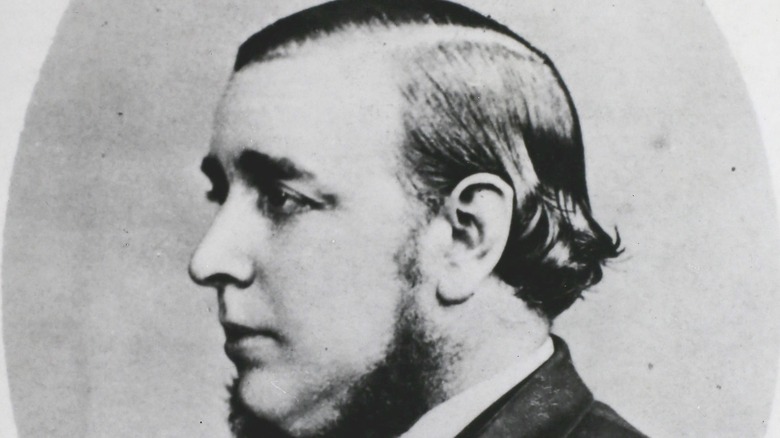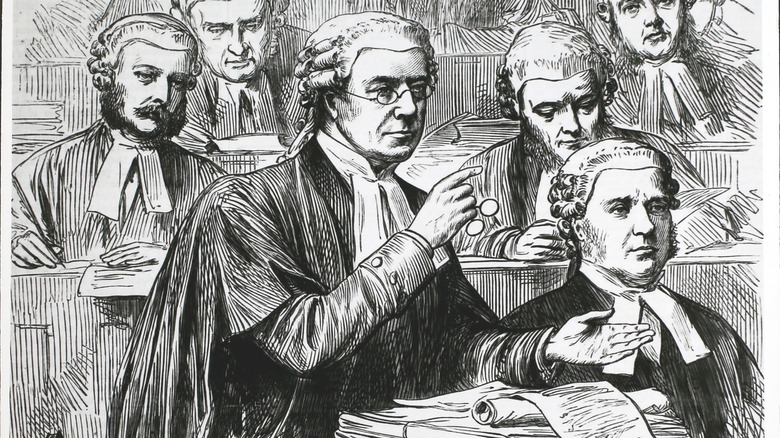The Mysterious Disappearance Of Roger Tichborne
A man named Roger Tichborne boarded a ship called the Bella in 1854 (via the State Library of New South Wales). In just under a week, the ship disappeared, and was assumed to be lost at sea. That was just the beginning of a story that spanned decades — and ended in an Australian national scandal.
Roger Tichborne was raised in a well-off family and was set to become the 12th baronet in his family's history. He spent his childhood exploring both Paris and England (via Historic Mysteries). After joining the military briefly, Tichborne left to spend time traveling. He set sail for Jamaica aboard the Bella on April 20.
But on April 24, remnants of the ship were found, and all of the passengers and crew were presumed to have been lost at sea. Finally, in 1855, Roger Tichborne was declared dead (via the State Library of New South Wales). Roger's mother, Lady Henriette Tichborne, always held out hope that her son was still alive. She had heard rumors that some of the ships' passengers were rescued by a ship heading to Melbourne, Australia. Lady Tichborne tirelessly followed international leads and put rewards and advertisements for her son's whereabouts in the newspapers.
Found alive after years of doubt
One day in 1863, a lawyer wrote to Lady Tichborne, claiming that Tichborne was alive and well, working as a butcher in Australia. Per Historic Mysteries, the lawyer had noticed the butcher smoking out of a pipe engraved with Roger's initials, and asked him directly if he was the man lost at sea. The man said yes. He was named Arthur Orton, also known as Thomas Castro, soon to be known as the long-lost Roger Tichborne, and later as the Tichborne claimant.
The physical differences between the two men were immediately apparent; Orton was shorter and heavier than Tichborne, and had a completely different accent. As the State Library of New South Wales reports, when Lady Tichborne met her "son" in person, she reportedly accepted Orton as her kin with no questions asked. She provided him with money and housing, and brought him to family events — but other friends and family members were more suspicious. Several years after Lady Tichborne died in 1868, the family brought perjury charges against this "Tichborne claimant," in 1871, according to Historic Mysteries.
Strange claims and mysterious origins
So why would the man claim to be Tichborne if he was not? Well, the Tichborne baronet would become the heir to the family's properties and land titles. As Historic Mysteries reports, the Tichborne claimant was hoping to make a better living through inheriting wealth, rather than working as a butcher. And he had been immediately rewarded for these efforts by Lady Tichborne, a grieving mother, who provided him with money and resources.
As Ennever reports, the case also received so much attention that the claimant gained celebrity status; to many people, it ceased to matter if he was actually Roger Tichborne, because the story was so outrageous. The media became infatuated with him. Photos of him were traded like baseball cards, he would be frequently invited to lavish dinners, shows, and dances, and he received lots of fan mail. The claimant even provided his own clothes for his wax figure likeness to wear at a Madame Tussaud exhibit.
There were only two daguerreotypes of Roger Tichborne in existence, making it difficult to know for certain if the Tichborne family really had reunited with Roger or not (via Ennever). As the State Library of New South Wales reports, there were nearly 100 people who defended the Tichborne claimant, saying he knew certain facts that only the real Roger Tichborne could know.
A web of lies unravels
However, he wasn't able to convince jurors that he was in fact the missing person — largely because he barely spoke French, which Roger spoke fluently, and he had a completely different accent (via the State Library of New South Wales). He had also contacted his real family behind the Tichborne family's back, which was revealed during the trial.
The claimant's posh lifestyle came to a crashing halt when in 1874, he was found guilty of perjury. He served a prison sentence of about ten years, according to the National Portrait Gallery. As Historic Mysteries reports, the only reason his sentence was shortened was that the Tichborne claimant and Roger Tichborne had the same genital malformity, raising doubts about the sentencing.
In 1895, the claimant confessed to be an imposter, but then refuted those claims later on (via the State Library of New South Wales). But the damage had already been done, and the claimant spent his last years living in poverty. In 1898, the Tichborne claimant died, leaving behind a national scandal and a mystery that may never be solved.



